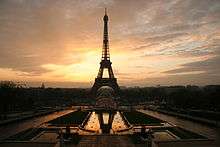Paris syndrome

Paris syndrome (French: Syndrome de Paris, Japanese: パリ症候群, Pari shōkōgun) is a transient psychological disorder exhibited by some individuals when visiting or vacationing to Paris, as a result of extreme shock resulting from their finding out that Paris is not what they had expected it to be. It is characterized by a number of psychiatric symptoms such as acute delusional states, hallucinations, feelings of persecution (perceptions of being a victim of prejudice, aggression, or hostility from others), derealization, depersonalization, anxiety, and also psychosomatic manifestations such as dizziness, tachycardia, sweating, and others, such as vomiting.[1] Similar syndromes include Jerusalem syndrome and Stendhal syndrome. The condition is commonly viewed as a severe form of culture shock. It is particularly noted among Japanese travelers.
History
Professor Hiroaki Ota, a Japanese psychiatrist working in France, is credited as the first person to diagnose the condition in 1986.[2] However, later work by Youcef Mahmoudia, physician with the hospital Hôtel-Dieu de Paris, indicates that Paris syndrome is "a manifestation of psychopathology related to the voyage, rather than a syndrome of the traveller."[3] He theorized that the excitement resulting from visiting Paris causes the heart to accelerate, causing giddiness and shortness of breath, which results in hallucinations in the manner similar to the Stendhal syndrome described by Italian psychiatrist Graziella Magherini in her book La sindrome di Stendhal.[4]
Susceptibility

Japanese visitors are observed to be especially susceptible.[2][5] It was first noted in Nervure, the French journal of psychiatry in 2004.[6] From the estimated six million yearly visitors, the number of reported cases is not significant: according to an administrator at the Japanese embassy in France, around twenty Japanese tourists a year are affected by the syndrome.[7]
Mario Renoux, the president of the Franco-Japanese Medical Association, states in Libération': "Des Japonais entre mal du pays et mal de Paris" ("The Japanese are caught between homesickness and Paris sickness", 13 December 2004) that [Japanese] magazines are primarily responsible for creating this syndrome. Renoux indicates that Japanese media, magazines in particular, often depict Paris as a place where most people on the street look like "stick-thin" models and most women dress in high fashion brands such as Louis Vuitton,[8] while in reality French high-fashion brands are mainly for foreign consumers, and the French population are far more overweight than the Japanese population.
As of 2004 the Japanese embassy runs a 24-hour help line to assist Japanese tourists suffering from this condition. The embassy also reported that at this time on average twelve people suffered from the disorder annually.[9]
Causes
The authors of the article, in the 2012 French psychiatry journal Nervure, cite the following as contributory factors for Japanese people:
- Language barrier – few Japanese speak French and vice versa. This is believed to be the principal cause and is thought to engender the remainder. Apart from the obvious differences between French and Japanese, many everyday phrases and idioms are short of meaning and substance when translated, adding to the confusion of some who have not previously encountered such.
- Cultural difference – the large difference between not only the languages but the manner. The French can communicate on an informal level in comparison to the rigidly formal Japanese culture, which proves too great a difficulty for some Japanese visitors. It is thought that it is the rapid and frequent fluctuations in mood, tense and attitude, especially in the delivery of humour, which cause the most difficulty.
- Idealized image of Paris – it is also speculated as manifesting from an individual's inability to reconcile a disparity between the Japanese popular image and the reality of Paris. The Japanese often picture Paris as a land of dreams, the land of beauty, culture and romance. However, they soon find out the contrary when they visit Paris for the first time. They find it to be a very regular place, the facilities are disorganized, many areas are unclean, and life characterized by noise, not like what was in their imagination.
- Exhaustion – the overbooking of one's time and energy, whether on a business trip or on holiday, in attempting to cram too much into every moment of a stay in Paris, along with the effects of jet lag, all contribute to the psychological destabilization of some visitors.
See also
Bibliography
- Notes
- ↑ Wyatt, Caroline (2009). "Mastering French manners, the hard way". BBC News. Retrieved 4 November 2009.
- 1 2 Wyatt, Caroline (20 December 2006). "'Paris Syndrome' strikes Japanese". BBC News. Retrieved 4 November 2009.
- ↑ (French) - Xaillé, Anne (21 November 2002). "Voyage pathologique: Voyager rend-il fou ? (Eng: Travel pathological: Traveling makes you crazy?)". The organization of the AP-HP. Retrieved 5 November 2009.
- ↑ Magherini, Graziella. La sindrome di Stendhal (in Italian) (1995 ed.). Ponte alle Grazie. ISBN 88-7928-308-1. - Total pages: 219
- ↑ Tamami, Katada (1998). "Reflexions on a case of Paris syndrome". Journal of the Nissei Hospital. Science Links Japan. 26 (2): 127–132. ISSN 0301-2581. Archived from the original on 30 October 2013. Retrieved 5 November 2009.
- ↑ Viala, A.; H. Ota; M.N. Vacheron; P. Martin; F. Caroli (June 2004). "Japanese pathological trip to Paris: an original model of cross-cultural management [in French]". Nervure Supplément. 17 (5): 31-34. Retrieved 11 July 2016.
- ↑ Chrisafis, Angelique (25 October 2006). "Paris syndrome hits Japanese". London: The Guardian. Retrieved 4 November 2009.
- ↑ Levy, Audrey. "Des Japonais entre mal du pays et mal de Paris". Libération (in French). Retrieved 25 November 2014.
- ↑ "'Paris Syndrome' strikes Japanese". BBC. Retrieved 2 August 2014.
- References
- Viala, A.; H. Ota; M.N. Vacheron; P. Martin; F. Caroli (2004). "Les Japonais en voyage pathologique à Paris : un modèle original de prise en charge transculturelle". Nervure Supplément. 17: 31–34. Retrieved 4 November 2009.
